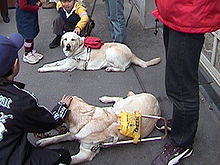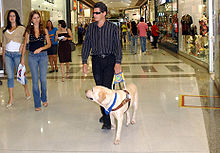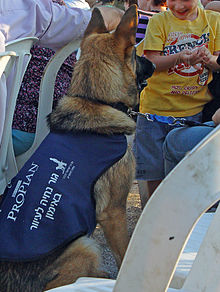- Guide dog
-
- For the 2010 album by Helmet, see Seeing Eye Dog.
 Elliot Aronson, a notable social psychologist and his guide dog, Desilu, whom he received in January 2011
Elliot Aronson, a notable social psychologist and his guide dog, Desilu, whom he received in January 2011
 Labrador Retriever guide dogs resting
Labrador Retriever guide dogs resting
Guide dogs (also called seeing-eye dogs) are assistance dogs trained to lead blind and visually impaired people around obstacles.
Although the dogs can be trained to navigate various obstacles, they are partially (red-green) color blind and are not capable of interpreting street signs. The human half of the guide dog team does the directing, based upon skills acquired through previous mobility training. The handler might be likened to an aircraft's navigator, who must know how to get from one place to another, and the dog is the pilot, who gets them there safely.
In several countries, guide dogs, along with most service and hearing dogs, are exempt from regulations against the presence of animals in places such as restaurants and public transportation.
Contents
History
References to guide dogs date at least as far back as the mid-16th century; the second line of the popular verse alphabet "A was an Archer" is most commonly "B was a Blind-man/Led by a dog"[1] In the 19th century verse novel Aurora Leigh by Elizabeth Barrett Browning, the title character remarks "The blind man walks wherever the dog pulls / And so I answered."[2]
The first guide dog training schools were established in Germany during World War I, to enhance the mobility of returning veterans who were blinded in combat. The United States followed suit in 1929 with The Seeing Eye in Nashville, Tennessee (relocated in 1931 to Morristown, New Jersey). One of the founders of The Seeing Eye was America's first guide dog owner, Nashville resident Morris Frank. Frank was trained with Buddy, a German Shepherd, in Switzerland in 1928.
The first guide dogs in Great Britain were German Shepherds. Three of these first were Judy, Meta, and Folly, who were handed over to their new owners, veterans blinded in World War I, on 6 October 1931. Judy's new owner was Musgrave Frankland.[3][4] In 1934 The Guide Dogs for the Blind Association in Great Britain began operation.[4]
Research
Important studies on the behavior and training methods of guide dogs were done in the 1920s and 1930s by Jakob von Uexküll and Emanuel Georg Sarris. They studied the richness of guide dogs and introduced advanced methods of dog training.[5]
Breeds
Early on, trainers began to recognize which breeds produced dogs most appropriate for guide work; today, Golden Retrievers, Labradors, and German Shepherds are most likely to be chosen by guide dog facilities, though by no means does this mean other breeds, such as Standard Poodles, Collies, Vizslas, Dobermans, Rottweilers, Boxers, Border Collies, and Airedale Terriers, are not. Guide dog breeds are chosen in relation to height at the shoulder measured against harness length and an individual's height.
Crosses such as Golden Retriever/Labrador (which are popular due to both breeds' known intelligence, work-ethic, and early maturation)[citation needed] and Labradoodles (Labrador/Poodles bred to provide dogs with less shedding for those with allergies to hair or dander) are also common.
Guide dog accessibility
Despite regulations or rules that deny access to animals in restaurants and other public places, in many countries, guide dogs and other types of assistance dogs are protected by law, and therefore may accompany their handlers most places that are open to the public. Laws and regulations vary worldwide:
- In the United States, the Americans with Disabilities Act prohibits any business, government agency, or other organization that provides access to the general public from barring guide dogs. However, religious organizations are not required to provide such access. The Fair Housing Act requires that landlords allow tenants to have guide dogs in residences that normally have a No Pets policy and no extra fees may be charged for such tenants. Whether guide dogs in training have the same rights or not usually falls on each individual state government.
- In most South American countries and Mexico, guide dog access depends solely upon the goodwill of the owner or manager. In more tourist-heavy areas, guide dogs are generally welcomed without problems. In Brazil, however, a 2006 federal decree requires allowance of guide dogs in all public and open to public places. The Brasília Metro has developed a program which trains guide dogs to ride it.
- In Europe, the situation varies[clarification needed]. Some countries have laws that govern the entire country and sometimes the decision is left up to the respective regions.
- In Malta, The Equal Opportunities Act 2000 states that it is illegal to discriminate against a disabled person who needs an assistant, in this case, a Guide Dog. The few exceptions are restaurant kitchens, Hospital special wards, toilets and premises where other animals are kept.
- In Australia, the Disability Discrimination Act 1992 protects guide dog handlers. Each state and territory has its own laws, which may differ slightly.
- In Canada, guide dogs are allowed anywhere that the general public is allowed.
- In South Korea, it is illegal to deny access to guide dogs in any areas that are open to the public. Violators are fined for no more than 2 million won.
Muslim objections
Further information: Islam and dogsBecause Islam considers dogs in general to be unclean,[6] many Muslim taxi drivers and store owners have refused to accommodate customers who have guide dogs.[7][8][9] However, in 2003 the Sharia Council, based in the United Kingdom, ruled that the ban on dogs does not apply to those used for guide work.[10]
Despite that ruling, many Muslims continue to refuse access and see the pressure to allow the dogs as a restraint upon religious liberty.[citation needed] Sheikh Ibrahim Mogra of the Muslim Council of Britain has argued strongly that Sharia does not preclude working with guide dogs, and it is actually a duty under Sharia for a Muslim to help the blind.[citation needed]
See also
References
- ^ Opie, Iona and Peter Opie, ed. The Webster Dictionary of Nursery Rhymes. Oxford: Oxford University Press, 1952.
- ^ Barrett Browning, Elizabeth. Aurora Leigh, Book V., ll. 1028-9.
- ^ Article(subscription required), The London Paper at exacteditions.com
- ^ a b History at The Guide Dogs for the Blind Association; retrieved 30 April 2011.
- ^ Uexküll, Jakob; Sarris, Emanuel Georg 1931. Der Führhund der Blinden. Die Umschau 35(51): 1014–1016.
- ^ Encyclopedia of Religion and Nature, s.v. "Dogs in the Islamic Tradition and Nature." New York: Continuum International, forthcoming 2004. By: Dr. Khaled Abou El Fadl
- ^ http://www.dailymail.co.uk/news/article-1295749/Muslim-bus-drivers-refuse-let-guide-dogs-board.html
- ^ http://www.christian.org.uk/news/muslim-drivers-barring-guide-dogs-from-vehicles/
- ^ http://www.telegraph.co.uk/news/newstopics/religion/7847571/Is-a-religious-bus-ban-on-my-dog-right.html
- ^ http://menmedia.co.uk/asiannews/news/s/480595_guide_dogs_not_haram_rules_shariah
External links
Listen to this article (info/dl)
This audio file was created from a revision of Guide dog dated 2006-03-09, and does not reflect subsequent edits to the article. (Audio help)More spoken articlesCategories:- Assistance dogs
- Blindness
Wikimedia Foundation. 2010.





